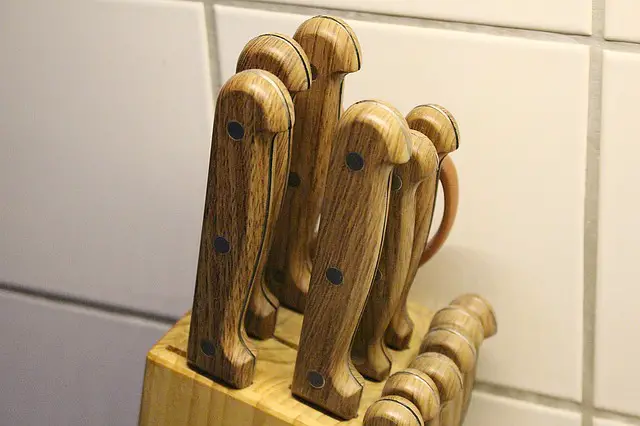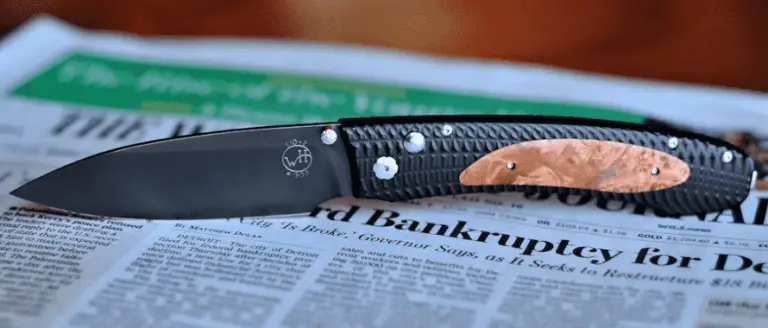In the world of sharp objects, the dagger and the knife are some mainstay citizens.
There is always the debate of what makes a dagger, if it is a type of knife is and when a dagger starts becoming a knife or vice versa.
Here, in this piece, is the dagger vs knife showdown that you have always wanted – and you won’t need any other piece than this one. I promise you that much.
So, how about I stop beating about the bush and go straight to the point?
Table of Contents
What Separates a Dagger from a Knife?
Here are the basic differences, discussed under multiple headings, between both blades.
Purpose – Self Defense and Cooking
A knife is primarily a kitchen utensil while daggers, by definition, are best suited for self-defense.
I did not say a cooking tool because knives can be used for other kitchen operations not directly related to cooking.
Likewise, knives can also be used for self-defense (as we have seen John Wick, Jason Bourne and Ethan Hunt do a couple of times) but the dagger (think back to the Game of Thrones) is best suited to this role.
Construction – Double-Edged or Singly Sharpened
The construction of the dagger makes it look like a small sword, considering the dual sharp edges sharpened sides. On knives, you would get only one sharp edge and an unsharpened spine on the other end (learn more about parts of a knife here).
This construction makes it easy to use the dagger as a close combat weapon while the single-edged knife is better for kitchen duties.
Sharpened Sides
You must have already gotten this from the above but knives have only one edge sharpened while daggers have both.
Swords are the only sharp objects of this form and build that should have both sides sharp. However, when they are not long enough, they are referred to as daggers.
Style
A glance at the knives on this chart shows you that there can be different knives for different purposes. From the utility knife to the basic kitchen blade and bread knife, there are just so many different types to pick from.
Some knives are designed that they look like daggers, even though they are not.
On the other hand, daggers do have their styles too. They can be specifically designed for fighting, stabbing, hunting, and even cutting.
History
The first knife, making its appearance around 500,000 years ago, was fashioned for kitchen duties. The first ones were made out of stone but with advancement, modern materials were employed for the creation of knives.
Daggers have also been present throughout history, finding favor with soldiers and enemy combatants at war. They were fashioned as blunt close combat weapons out of bone, ceramics, and other ancient materials.
Again, this does not mean that knives don’t make it to the fight scene, but they are not as favorable.
Range
Perhaps the best difference between daggers and knives is in the range of use that they bring to the table.
You can use some knives in the kitchen, take some with you (pocket knives) as utility blades and even subscribe to the idea of specific fighting knives.
With daggers, you can try to do that too but you would not do better than using it as what it is – a tactical blade.
That range makes owning a knife a much more practical application in this age and time, even for the things that daggers are capable of.
Design
You already see the different kinds of knife blade designs from the identification chart referenced above.
Of course, they have a pointed blade but the handle is typically the same on all knives.
Since the back is the blunt side, the handle doesn’t prevent the user’s hand from sliding over to the spine. On a dagger, the handle is designed with a hilt that keeps the user’s hand safe when they, for example, stab something.
Weight
The average dagger does not only boast a considerable length advantage over knives but also tips the scales at higher numbers too.
The weight makes it better balanced, and a primarily better tactical tool for thrusting operations. Since it is also required in combat situations where hitting bones with force and doing other heavy-duty tasks is not negotiable, it must not be flimsy.
The knife, on the other hand, is designed for simpler, better handling without feeling too much stress on the hand.
We could make an argument with multipurpose knives too. Seeing how many moving parts go into those knives and how the weight ultimately compares to a dagger, they are still not related in this category.
Carry Laws
When I discussed open carry laws across the US and other parts of the world, you would observe that I stuck with knives only.
Even at that, these laws are still dicey and you could get in trouble from the wrong interpretation of a part of the law. Best believe that if you go out with a dagger, you would be specifically breaking the law in most places.
Unless you have a permit, it is too dangerous a tool to have on your person.
The dagger has done so much bad in history already, most notably in the killing of Julius Ceaser, and no one is about to have that around anymore.
Safety of Use
Perhaps the biggest difference between these blades, for me, is how safe they are.
For a tool that was designed to inflict maximum damage on whoever it is used on, we should not expect much from it in terms of safety. Yes, we are looking at you, Mr. Dagger.
If you respect your knife and keep to these safety rules (download a free knife safety infographic for your kitchen here), you should be fine. I have used knives for many years now and I have only ever slightly cut myself with the edge – since it is not a weapon.
Handling
Handling a knife outside of its sheath is pretty much easy and straightforward.
Only one sharp edge is there anyway, so you don’t need to worry too much about slashing someone with a backhand.
If you don’t have any prior training, though, I don’t see what you are doing with a dagger.
You could collect them or admire them, but do not play with them. That is not what they are for.
Frequently Asked Questions
Here, I hope to answer some of the burning questions that must have formed in your minds about these knives, daggers, and knives-daggers that look like the product of these two tools.
Are Dirks illegal?

The dirk is considered in history to be one of the favorite weapons of naval officers and is thus, illegal to take outdoors with you. They can be used in your home but, like stilettos, double-edged knives, and ballistics, among other things, cannot be openly carried.
Is a dagger a sword?
Daggers share the same basic design as the sword, from the choice of material to hilt design, sheath, and dual edges. However, they are not the same. In some instances, a dagger can be considered to be a small sword instead,
Is the bowie knife a dagger?
The bowie knife is just that – a knife. The confusion comes from this type of knife coming in length variations resembling a dagger/ sword, featuring dual edges on some options, and even having a hilt.
Even as a knife, though, don’t try to open carry this guy. Else, you’re asking for an arrest and could endanger yourself/ those around you.
Final Thoughts
All the basic and interesting differences between a knife and a dagger have been explained up there. I believe right now, your search for what makes these two tools different (as well as similar in some instances) must have been satisfied.
If there is anything else you would like to know, you can reach me in the comments.





![What Is A Paring Knife Used For? [Uses, Best Brands & FAQs]](https://cutsandcarves.com/wp-content/uploads/2021/05/What-Is-A-Paring-Knife-Used-For-Uses-Best-Brands-FAQs-768x1024.jpg)

